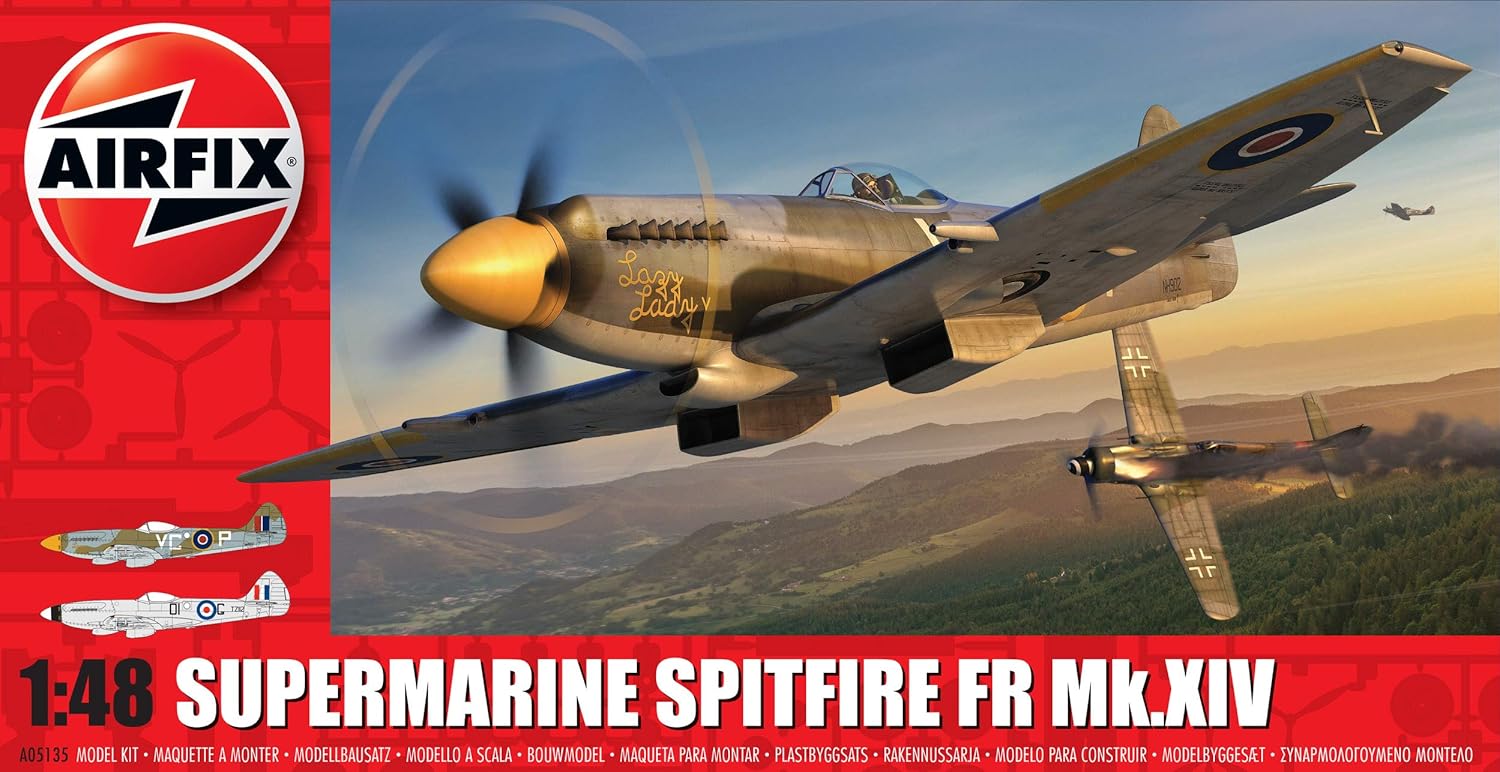
591 reviews analysed
1. Airfix Hawker Hurricane MK I Tropical 1:48 Military Aircraft Plastic Model Kit
Feature
- 1:48th Scale WWII Military Aircraft Plastic Model Kit
- Livery A: F H Dean, No. 274 Squadron RAF, Sidi Barrani, Egypt 1941 Livery B: Rhodesian Air Training Group, Rhodesia 1941
- Skill Level: 2 Number of Parts: 127
- Humbrol Paints needed are listed on the outside of the box
- Construction and painting required: yes, glue and paints need to be purchased separately
Description
The rugged and reliable Hawker Hurricane was arguably the most important fighter aircraft available to the Royal Air Force at the beginning of WWII. Easier to produce and more forgiving to fly than the more glamorous Spitfire, the Hurricane was available in much greater numbers than any other fighter at the time of the Battle of Britain and proved decisive in securing eventual victory for the pilots of the RAF. Early RAF operations in the Mediterranean and North Africa saw small numbers of Hurricane Mk.I fighters pitted against vastly superior numbers of Regia Aeronautical aircraft. They proved to be more than a match for anything the Italian Air Force could hurl at them, but the arrival of battle hardened Luftwaffe fighters in 1941 saw a change in fortunes. Many of the Hurricanes were ‘Tropicalized’ and arrived in theatre with the chin mounted Vokes carburetor dust filter, which significantly altered the profile of the Hawker fighter.
2. Airfix Hawker Sea Hurricane MK.IB 1:48, A05134
Feature
- 1: 48th scale WWII military aircraft plastic A05134 kits
- Scheme 1- Hawker sea hurrican Mk ib, aircraft flown by Lieutenant Richard John (dickie) cork (dso & dsc), no 880 Naval air squadron, fleet air arm, HMS indomitable operation
- Skill level: 2 number of parts: 127
- Humbrol paints needed are listed on the outside of the box.
- Construction and painting required: yes, glue and paints need to be purchased separately
Description
Having proved itself during the savage dogfighting of the battle of Britain, the Hawker HURRICANE would also make a valuable contribution in protecting the vital sea lanes from German attack, both above and below the water. Modified with the addition of catapult spools and a fuselage mounted arrester hook, sea Hurricanes were embarked aboard Britain’s diminutive aircraft carriers from mid 1941. As British shipping losses in the Atlantic began to mount, it became clear that the royal Navy needed a fast, capable monoplane fighter that could be operated effectively at sea. At this time, the British fighter of the moment was the Supermarine Spitfire, but all production was destined for the RAF who were desperate to replace the losses suffered during the battle of Britain and the Navy would be disappointed. Even though other aircraft were favoured by the Navy, such as the American Wildcat, the venerable Hawker HURRICANE was selected for the task and once again this superbly versatile aircraft answered its country call. Initially operating from rocket powered catapults mounted on specially modified merchant vessels, all the early naval Hurricanes were refurbished, war weary RAF machines, but they provided the convoys with invaluable aerial support in the battle against axis Raiders. The later sea HURRICANE ib was equipped with catapult spools, an arrester hook and a multitude of additional modifications to ensure effective operation at sea. These fighters operated from Britain’s relatively small aircraft carriers and specially converted merchant vessels, known as Mac ships. The large wing area and forgiving handling qualities of the HURRICANE made it particularly suitable for operation from the rolling deck of an aircraft carrier at sea and it provided excellent service until more capable British and American naval fighters became available. Please note, box and A05134 dimensions are shown as identical however only represent the box/package size.
3. Revell 04144 Hawker Hurricane Mk.IIC Model Kit
Description
Product Description
Hawker Hurricane Mk. IIC Model Kit
Set Contains:
Model Kit, Decals, Instructions.
4. Airfix WWII Curtiss P-40B Warhawk 1:48 Military Aircraft Plastic Model Kit
Feature
- 1:48th Scale WWII Military Aircraft Plastic Model Kit Skill Level: 2 Number of Parts: 106
- Livery A: P40B Lt. George Welch, 47th PS, 15th PG, December 1941 Hawaii
- Livery B: Hawk 81-A-2 No47 (P-8127) Robert T. Smith, 3rd Squadron (Hell’s Angels) American Volunteer Group, Kunming, China, June 1942
- Humbrol Paints needed are listed on the outside of the box.
- Construction and painting required: yes, glue and paints need to be purchased separately
Description
During the early stages of WWII, the American built Curtiss P-40B proved to be one of the most important fighter aircraft available to Allied Air Forces. Flying with the RAF in North Africa and the American Volunteer Group in China, the Allison V-1710-33 powered P-40B was to became one of the most distinctive fighters of the entire war, wearing their fearsome shark-mouth artwork. Arguably, the most striking versions of the P-40 were the early machines, which displayed an extremely sinister profile – with a shorter, more pointed nose and an extremely throaty Allison V-1710 engine, the P-40B (Tomahawk IIa in RAF service) aircraft looked almost like flying Great White sharks. When RAF No.112 Squadron of the Desert Air Force added aggressive looking sharks teeth and eyes to their aircraft in 1941, they inadvertently turned their Tomahawks into some of the most iconic aircraft of WWII and certainly some of the most visually appealing. These designs would find their way on to many different aircraft throughout the remainder of the war, but the RAF Desert Air Force certainly started the trend. Livery A: P40B Lt. George Welch, 47th PS, 15th PG, December 1941 Hawaii Livery B: Hawk 81-A-2 No47 (P-8127) Robert T. Smith, 3rd Squadron (Hell’s Angels) American Volunteer Group, Kunming, China, June 1942
5. Hasegawa JT51 Plastic Model kit
Description
Hasegawa 1:48 Hawker Hurricane Mk.IIC
6. Airfix 1:72nd Scale WWII Grumman F4F-4 Wildcat Plastic Model Kit
Description
The F4F Wildcat was the US Navy’s primary carrier borne fighter aircraft at the start of the Second World War. Characterized by its stubby appearance the Wildcat had been developed from Grumman’s successful range of pre-war biplanes and had entered service with the US Navy a year prior to the Japanese attack on Pearl Harbor. By the time of the crucial battles from Midway and Guadalcanal the F4F-4 model had become the most numerous variant and new tactics enabled American naval and marine pilots to gain the upper hand on the previously all-conquering Mitsubishi Zero.
7. Airfix Hawker Sea Fury FB.11 ‘Export Edition’ 1:48 Military Aircraft Plastic Model Kit A06106
Feature
- Being a slightly larger scale, 1:48 allows modelers to add those intricate details that is absent from smaller scales.
- Skill Level: 2 Dimensions of Completed Kit: Length 231mm x Width 244mm Number of Parts: 122
- Scheme 1: VW645 Sydney August 1955 Scheme 2: FB11 803 Squadron Royal Canadian Navy 1948 Scheme 3: Sea Fury FB. MK50 no860 Squadron Royal Dutch Navy – Aerobats
- Painting required: yes, paints need to be purchased separately.
- Humbrol Paints needed are listed on the outside of the box.
Description
The last in an illustrious line of Hawker piston engined fighters, the Sea Fury entered service with the Royal Navy too late to see operations during WWII, but proved to be one of the fastest propeller driven aircraft ever produced. Attracting plenty of overseas interest, the Sea Fury was also operated in some numbers by the navies of Holland, Australia and Canada, with Australian Sea Fury’s making a significant contribution to air operations during the Korean War.
8. Airfix A01003 Curtiss Hawk 81-A-2 Model Building Kit, 1:72 Scale
Description
From the Manufacturer
Flying the Curtiss Hawk 81-A-2 from late 1941 the Flying Tigers, known officially as the 1st American Volunteer Group, were a unit of the Republic of China Air Force.
9. Airfix 1:72nd Scale WWII Bristol Beaufighter TF.X Plastic Model Kit
Description
The Bristol Beaufighter was a WWII British long range heavy fighter, developed from the earlier Beaufort design. Featuring two powerful Bristol Hercules engines, the aircraft gained a fearsome reputation for being both fast and able to deliver a powerful blow from its four 20mm cannons and a choice of either Torpedo or Rocket projectiles. Although developed to be a fighter, and used successfully as a night fighter, it was the TF.X Coastal Command version that was most successful; its range and power enabling it to take a heavy toll of Axis shipping.
10. Airfix Supermarine Spitfire FR MK XIV 1:48 Military Aviation Plastic Model Kit A05135
Feature
- Being a slightly larger scale, 1: 48 allows Modelers to add those intricate details that is absent from smaller scales.
- Skill level: 2. Dimensions of completed kit: length 206mm x width 209mm. Number of parts: 118.
- Primary scheme: Super marine Spitfire favorite Mk XIV flown by Squadron leader James Bernard Prendergast, no 414 Squadron, royal Canadian air Force, B156 Luneburg, Germany may/June 1945. Scheme 2: Super marine Spitfire Mk XIV no 11 (AC) Squadron, RAF, second tactical air Force (2TAF), RAF buckeburg, Germany 1950-1951.
- Painting required: yes, paints need to be purchased separately.
- Humbrol paints needed are listed on the outside of the box.
Description
Continuing the wartime development of the famous Super marine Spitfire, the mk. Xiv saw the classic shape of Mitchell’s celebrated fighter paired with the awesome power of the new rolls Royce Griffon engine. The aircraft was superb and one of the RAF’s most capable fighters of WWII, proving particularly successful when employed against the V-1 flying bomb attacks which Germany launched against Southern Britain, from the summer of 1944. The adoption of the Rolls-Royce Griffon engine provided the Spitfire with a significant increase in performance, but not without presenting Super marine designers and pilots converting to the aircraft with a few challenges. Installation of the new engine in the existing Spitfire airframe required a redesign of both the front and rear sections of the aircraft and the use of a distinctive five bladed rotol propeller. Pilots used to flying Merlin engine versions of the aircraft would find the Griffon turned in the propeller in the opposite direction and whilst the earlier aircraft tended to veer to the left on take-off, the Griffon powered machines would veer in the opposite direction – if the pilot forgot and applied their usual corrective inputs, their first Flight could be a particularly short and uncomfortable one. As the only British fighter Type to remain in production throughout WWII, the Spitfire was constantly developed to ensure it remained at the forefront of fighter performance, with the Griffon powered aircraft being around 80 mph faster than the original Mk. I machines. With the purr of the early Merlin engines replaced by the throaty growl of the mighty Griffon, these later developments appear to be much more capable versions of the fighter than the classic early Spitfires, even though they are basically a development of them. The Griffin powered Spitfire Mk. Xiv possessed greater performance than that of the thoroughbred Mk. Ix and therefore was superior to both the Luftwaffe Focke Wulf Fw 190 and the latest versions of the Messerschmitt Bf 109. Taking part in air operations in support of and in the months following the D-Day landings, the mk. Xiv was used extensively by the 2nd tactical air Force, equipping all 20 of the Spitfire squadrons that operated from the continent in the months between D-Day and ve-day. Employed predominantly in an armed reconnaissance role, these fearsome fighters would search for targets behind German lines, attempting to disrupt both their retreat and their ability to send reinforcements to the current front line. Their speed also made them an ideal aircraft to help counter The growing Doodlebug threat endured by Southern Britain in the months following operation Overlord and the D-Day landings.
Conclusion
By our suggestions above, we hope that you can found Hawker Hurricane 148 for you.Please don’t forget to share your experience by comment in this post. Thank you!

























